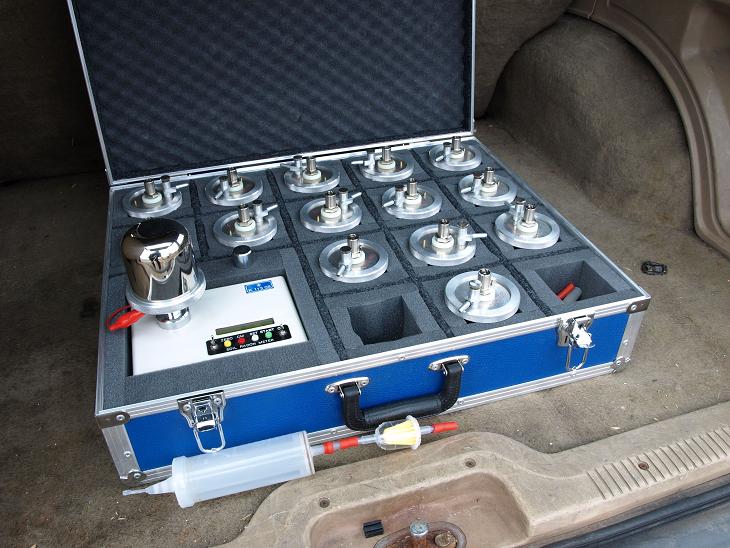|
Radon detector
RM-2
Portable instrument for in situ
measurement of soil-gas radon concentration
APPLICATIONS
The RM-2 Radon detector is
designed for in situ rapid and accurate analysis of radon (222Rn) in
soil gas and therefore is well applicable to radon risk mapping and assessment
of radon content in foundation soils. Due to its unique characteristics it can
be used as well for various geophysical applications such as uranium
exploration, assessment of radon at uranium mines and uranium tailings, geochemical
mapping and identification of lithological boundaries, locating of faults and
fracture zones, radon measurement at oil-fields, and predictions of earthquake
and volcanic eruptions.
 
RADON IN SOIL GAS
Uranium and thorium
generate by their decay radioactive gases radon (222Rn, T½
= 3.82 days) and thoron (220Rn, T½ = 54.5 seconds), both
sources of alpha radiation, which differ by their half-lives T½. The
usual radon and thoron activity concentrations in soil-gas range from 10 to 100
kBq/m3, while some anomalies may attain values up to several
thousands of kBq/m3. This contrasts to RM-2 high detection
resolution 0.1kBq/m3. Radon migrates by diffusion and convection at
distances up to tens of metres in the rock environment.
RM-2 MEASURING FEATURES
Radon detector RM-2
consists of a set of fifteen ionization chambers IK-250, the reader ERM-3 and a
soil-gas sampling set. Samples of soil-gas are collected through hollow steel
rods by means of a plastic large-volume syringe and transferred to evacuated
ionization chambers. In order to eliminate thoron, ionization chambers with
soil-gas samples are measured with specific time delay of 15 minutes after
sampling. Alpha radiation of radon in soil-gas sample give rise to ionization
current in the ionization chamber, which is measured within 120 s. The
pre-programmed, fully automatic reader ERM-3, with installed calibration
constant, displays the concentration of radon in units of volume activity
(kBq/m3). Estimates of thoron are possible. Main features of the
RM-2 radon detector are:
·
Modern construction using up-to-date electronics
·
PC control via RS232 interface
·
Memory and adjustable calibration constant
·
Digital data storage into the memory
·
Cyclic radon recording
·
Easy front panel instrument control
·
120 s pre-programmed exposure time
·
Fully automatic reader operation
·
16 digit LC display
·
Calibration at radon chamber tied to
international standards
·
Extremely sensitive – detection resolution 0.1
kBq/m3
·
Low power consumption
·
Lightweight and rugged
·
Easy detector cleaning and maintenance
DESCRIPTION
Cylindrical ionization
chambers IK-250 with a detection volume of 250 cm3 are steel pressed
pieces with sheet metal thickness of 0.8 mm. The brass axial collection
electrode passes through a teflon insulator serving as high performance
electrode voltage separator. The described set is fastened in an insulating
bushing placed in the upper part of the ionization chamber. A three-way inlet
valve provides input of the soil-gas sample into the ionization chamber. The
input hose can be equipped with a filter eliminating input of radon decay
products into the ionization chamber. The radon detection system operates in
two selectable modes; (i) measurement starting 15 minutes after the transfer of
the soil-gas sample into the ionization chamber, and (ii) measurement conducted
after time delay of 3 hours making the use of alpha radiation of radon and its
short-living decay products in radioactive equilibrium. Exposure time 120
s is applied per one sample. Applied voltage between electrodes of the
ionization chamber is 40 V (DC). The detector operates in a non-saturated
sector of the volt-ampere characteristic of the ionization chamber (interval of
proportionality), approximately at 85 % of the level of the saturated current.
The ionization current is amplified, electronically and statistically
processed, and processed resultant value is subsequently displayed and stored
in the memory. The reader ERM-3 enables the current signal recording each 2 s
(cyclic mode), that is useful for specific measurements of radon and thoron
mixture and other investigations. A standard serial communication interface
RS232 serves for connecting with a PC, data transfer, entering the calibration
constant and other operating instructions. Basic measuring functions are set-up
from the ERM-3 control panel manually.
SPECIFICATIONS
| Detector |
Ionization
chamber IK-250 |
| Detector volume |
250
cm3 |
| Operating voltage of the detector |
40 V |
| Ion. chamber radon current sensitivity |
3.3 10-15 A per Bq/m3
of radon |
| Measuring range |
3
– 1200 kBq/m3 |
| Detection resolution |
100 Bq/m3 |
| Weight |
0.31
kg |
|
|
| Electrometer (reader) |
model ERM-3 |
| Operating external temperature range |
5 – 40 ºC |
| Relative air humidity |
max 70 % |
| Atmospheric air pressure |
60 – 106 kPa |
| Storing and transport conditions |
-25 - +55 ºC |
| Power supply |
Battery
9 V (6F22), battery life cca 50 hours and/or Built-in accumulator, Voltage adapter 12V/500 mA |
| Dimensions |
190
x 135 x 80 mm |
| Weight |
3.61
kg |
|
|
| Total weight (Reader + 15 ionization chambers +
transport case) |
11.5 kg |
| RM-2 Radon detector instruction manual |
|
Accessories
:
SOIL-GAS
SAMPLING SET
EQUIPMENT
FOR IN SITU PERMEABILITY MEASUREMENTS RADON - JOK
|